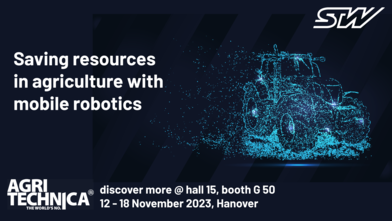More than almost any other industry, agriculture attaches great importance to the careful use of available resources. Agricultural machinery must also work as efficiently and precisely as possible in order to maximize harvest yields. Mobile robotics concepts can make a significant contribution to achieving both goals.
Ideas and concepts for mobile robotics or machine swarms on agricultural land have been around for many years. These are often fully autonomous concepts. Full autonomy places the highest demands on the functional safety of the machines as the protection of people, other living beings and objects in the vicinity of the autonomous mobile devices must be assured at all times.
The specialists for functionally safe automation at STW in Kaufbeuren focus on more implementation-friendly concepts. A control center monitored by an operator controls a multitude of automated machines conducting work in the field, such as fertilizing or field maintenance. In case of doubt, however, the human operator can intervene, assess, and resolve the situation in an emergency. This approach removes many of the hurdles of fully autonomous concepts, but maintains many of the advantages in terms of efficiency and sustainability.
Compared to conventional agricultural machinery use, with a control station concept, the operator can fully concentrate on monitoring the processes. Fatigue is reduced and operator wellbeing is better protected. The use of many smaller robots is also beneficial for the soil and the environment, as soil compaction and emissions are significantly reduced compared to large machines. Labor requirements are kept low, with one person able to supervise several machines at the same time. This is a big advantage for these concepts, given the ever-increasing shortage of skilled labor in agriculture.
Recently, at the GaLaBau exhibition demonstration area STW demonstrated how such a concept could look in practice. Together with the high grass mower manufacturer AS-Motor and the Fraunhofer Institute for Transportation (IVI), a control station monitored three autonomous mowing robots and coordinated the mowing of a predefined field.
STW offers the sensor technology, control technology and telematics components for these applications. Visitors to Agritechnica in Hanover can experience the STW portfolio firsthand at Stand G50, in Hall 15 from the 12th to 18th of November.
